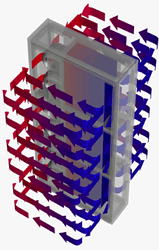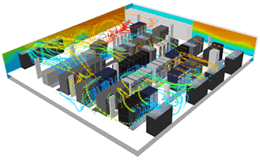Liquid Cooing: Powerful Cooling for Today’s Data Center
Abstract
Organizations are increasingly evaluating and implementing liquid cooling solutions to meet the heat challenges of blade servers and high-density computing. Liquid cooling solutions utilize air/liquid heat exchangers to provide quiet, uniform, effective cooling.
Many IT professionals list cooling as a top issue in data center management, as excess heat and high temperatures can shorten equipment lifespan, cause system downtime, and negatively affect equipment performance. As organizations add blade servers to their IT infrastructure, server rooms and datacenters demand more electricity and produce more heat, with some high-density racks exceeding 30 kW and some experts estimating up to 50 kW per server rack, within the next five years. (1)
Power and Cooling Trends
The increasing power and cooling demands of new equipment increase costs to levels so high that they may largely offset the financial and productivity benefits of the equipment. Some experts estimate that over a server’s three-year lifespan, its power and cooling costs may be greater to or equal to the cost of the equipment itself. (2) In addition, the high heat loads in many data centers make it difficult or impossible to accommodate new equipment purchases, restricting expansion and limiting the growth of organizations and businesses.
To meet the challenges of blade servers and high-density computing, organizations need effective cooling and heat management solutions, and many are turning to liquid cooling. These solutions utilize air/liquid heat exchangers to provide quiet, uniform, effective cooling and isolate equipment from the existing HVAC system. Liquid cooling is a powerful alternative to ambient air cooling, as water can carry about 3,500 times more heat than air. (3) While water is often used in liquid cooling, liquid refrigerants can be used as well, as their heat transfer properties are similar to water.
Liquid Cooling: Past and Present
Historically, liquid cooling solutions were successfully and safely used to cool high-heat mainframe computers. Yet, as power consumption and densities fell to less than 5 kW per rack, air cooling became the standard technology. With the increasing need to again turn to liquid cooling the American Society of Heating, Refrigerating and Air-Conditioning Engineers (ASHRAE) recently published a book entitled “Liquid Cooling Guidelines for Datacom Equipment Centers” that discusses standards and technologies related to data center liquid cooling, designs, and implementations.
 Current Liquid Cooling Solutions for the Data Center
Current Liquid Cooling Solutions for the Data Center
There are several types of liquid cooling solutions that are being used in data centers:
- Modular Liquid Cooling Units: These solutions are used within a fully sealed cabinet and are mounted at the rack base, in a rack “side car” with cooling modules that can provide a total cooling capacity of 30kW. Rittal offers several Liquid Cooling Packages that utilize variable speed fans and controlled water flow based on real-time heat load within the rack.
- Door Units: Door solutions feature full-door units that replace a standard server rack door and contain sealed tubes filled with chilled water.
- Integrated Rack-Based Liquid Cooling: Integrated solutions incorporate a rack-based architecture that integrates UPS power, power distribution, and cooling and feature a cooling distribution unit (CDU) that pumps water through aluminum/plastic tubing to coils to cool servers.
- Liquid Cooling/Heat Exchangers for Hot Spots: These solutions utilize heat exchangers fed by chilled water or liquid refrigerant to blow cool air directly into hot spots using the same liquid coolant used by the CRAC units in the room. (4)
- Device-Mounted Liquid Cooling: There are solutions available that work at the device level, with coolant routed through sealed plates on the top of a CPU. As the liquid (dielectric) takes heat from the device, it turns to gas and is then exhausted into the hot isle.
Liquid Cooling Considerations
In general, when datacenter managers are considering implementing a liquid cooling solution, they will want to take into account a variety of factors, including room humidity, condensation, and temperature; possible water/refrigerant piping corrosion issues; and flooring surface. In addition, if water (rather than liquid refrigerant) is used, ASHRAE recommends that the water be soft, deionized, distilled, or treated with reverse-osmosis (5). It is also important to consider current and anticipated future heat load and access/connections to adequate and reliable electrical and water/refrigerant supplies.

Implementing Liquid Cooling Solutions in Your Data Center
Our consultative sales team can help guide you through the process of implementing a liquid cooling solution in your datacenter. The team at 42U specializes in needs assessment, solution design, and implementation support to ensure that IT professionals maximize their use of current technologies to improve overall business performance. 42U provides complete server management solutions, including KVM over IP, intelligent power, environmental monitoring, rack cooling, and rack mount solutions. A 42U sales engineer can help you improve your data center performance by helping you select solutions that are most appropriate for your organization’s particular needs and environment.
References
(1) Brill, K. (2005) “2005-2010 Heat Density Trends in Data Processing, Computer Systems and Telecommunications Equipment.” Uptime Institute. http://www.upsite.com/resources/education-center/106-white-papers-research. (Free Account required for download) See Also: Mitchell, Robert, (2007)”The Liquid Data Center.” CIO Magazine (source: Computerworld Today, Australia.)
(2) “The Path to Efficient Energy Consumption and Cost Savings in Your Data Center ” Uptime Institute.
http://www.upsite.com/documents/whitepapers/best_practices_the_path_to_efficient_energy_consumption_low.pdf See also: Brill, K “Data Center Energy Efficiency and Productivity” http://www.uptimeinstitute.org/symp_pdf/(TUI3004C)DataCenterEnergyEfficiency.pdf
(3) Stansberry, Matt. “Liquid cooling book promotes standardization” SearchDataCenter.com http://searchdatacenter.techtarget.com/originalContent/0,289142,sid80_gci1218484,00.html
(4) Mitchell, Robert, (2007). “The Liquid Data Center.” Computerworld Magazine http://www.computerworld.com/s/article/282287/The_Liquid_Data_Center
(5) ASHRAE, (2006). “Liquid Cooling Guidelines for Datacom Equipment Centers” ISBN-10: 1-933742-05-4; ISBN-13: 978-1-933742-05-2.




